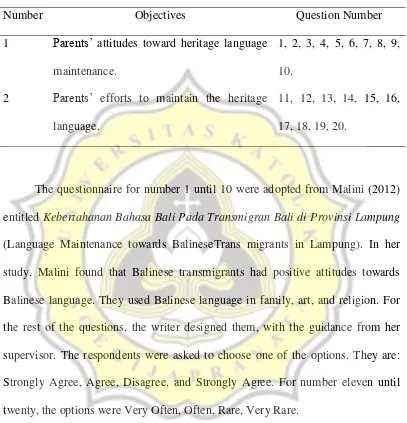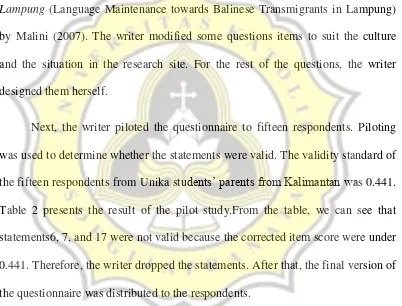CHAPTER III
RESEARCH METHODOLOGY
3.1 Data Collection
In this study, the writer examined parents’ attitudes towards heritage language and their efforts to maintain the heritage language. To address those research questions, the writer employed quantitative method. Quantitative method is a method that uses numeric and manipulation of observation to describe and explain the phenomenon of observation (Babbie, 1979). Quantitative method also points out the systematic and qualification of variables, the use mathematic models and causal inference, and statistical analysis of quantitative data (Johnson, 1992).There are nine characteristics of quantitative research. Quantitative method finds out the facts or causes of the phenomenon. Next, quantitative method is obtrusive and controlled measurements. Third, it was objective. Then, the quantitative method is an outside perspective. Later, it is underground, reductionist, verification oriented, and hypothetic – deductive. Furthermore, it is outcome – oriented. The quantitative method is also reliable (hard and replicable data). Other characteristics are generalized; multiple case studies. Last but not least, it is particularistic (Oakley, 1991).
maintain the heritage language. After distributing the questionnaire, the writer analyzed the data by using SPSS and then presented the findings.
3.1.1 Participants
In this study, the participants are the parents of Chinese Indonesian students who come from Kalimantan. The writer chose students’ parents from Kalimantan as respondents because the writer is Soegijapranata Catholic University’s student and she has easy access to the respondents. Basedon 2016 data from Biro Manajemen Sistem Informasi (BMSI), there were 178 participants who came from Kalimantan. To get 95 % perfect confidence, according to Cohen, Manion, & Morrison (2007), this study needed 135 participants.
The respondents are Soegijapranata Catholic University (later the writer will call it “Unika”) students’ parents who are from Kalimantan. 74 respondents
are men and 61 respondents are women. Most of them are 40 until 60 years and high school graduates and undergraduates. Almost half of them are entrepreneurs. Others are employee (22.2%), civil servant (6.7%), and others (21.5%).
this case, the writer used questionnaire to collect the data. The writer asked the respondents to fill out the formand check statement options ranging from Agree or Disagree to represent the points of their view (Babbie, 1979). The reason why the writer chose questionnaire to collect the data was because itwas more effective to collect the data. It needed less time, inexpensive, and could obtain data from the larger sample (Gay, 1987).
There are two kinds of questionnaire, open-ended questionnaire and close-ended questionnaire. Close-close-ended questionnaire is a questionnaire that prescribes categories of responses that respondents may choose. For example, Strongly Agree, Agree, Neutral, Disagree, and Strongly Disagree. Open-ended questionnaire contains questions that the respondents need to give descriptive answers. It is usually used when the researcher needs more explanation from the respondents. Responses to questionnaires usually reflect (Cohen, Manion, & Morrison, 2007).
For this study, the writer chose close-ended questionnaire. The questionnaires consisted of 20 statements. Statements number one until ten were about the parents’ attitudes towards heritage language and questions number eleven until twenty were about the parents’ efforts to help the children maintain
Table 1
Instrument Analysis
Number Objectives Question Number
1 Parents’ attitudes toward heritage language maintenance.
1, 2, 3, 4, 5, 6, 7, 8, 9, 10.
2 Parents’ efforts to maintain the heritage language.
11, 12, 13, 14, 15, 16, 17, 18, 19, 20.
First the writer determined the participants. The sample of this study was the student’s parents in Unika who are from Kalimantan. As previously stated, the
total respondents are 135 people. The respondents should be able to speak Mandarin language as their daily language.
Second, the writer made questionnaire. The writer adopted questionnaire research entitled Kebertahanan Bahasa Bali Pada Transmigran Bali di Provinsi Lampung (Language Maintenance towards Balinese Transmigrants in Lampung) by Malini (2007). The writer modified some questions items to suit the culture and the situation in the research site. For the rest of the questions, the writer designed them herself.
Next, the writer piloted the questionnaire to fifteen respondents. Piloting was used to determine whether the statements were valid. The validity standard of the fifteen respondents from Unika students’ parents from Kalimantan was 0.441.
she was worried that not all the parents could use computer and do online questionnaire.
After the data were collected, the writer analyzed them using SPSS 16.0.So the writer got the results in numeric form. Finally, the writer interpreted the data.
3.1.4 Method of Data Analysis


